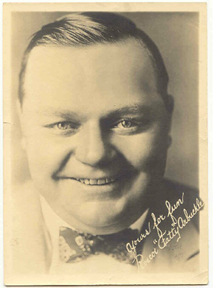For this week’s Free Roscoe Friday offering, we’re sharing a video tribute to Roscoe Arbuckle. One might wish the quality of the video were a bit better, but it’s otherwise a nice piece of work.
Remember that we’re marking the 125th anniversary of Roscoe’s birth by giving away three copies of The Forgotten Films of Roscoe “Fatty” Arbuckle.” It’s a four-disc DVD set that features 32 restored comedy classics.
And you can enter in a myriad of ways (and on a daily basis). Follow the link to your left to enter; retweet one of our “Free Roscoe” tweets on Twitter. Like and/or share one of our “Free Roscoe” posts on Facebook. Like or reblog one of our Arbuckle-themed posts on Tumblr. Heck, you can even share a Free Roscoe post on Google+, if you like.
You’ve got till March 31st to load up on entries and improve your chances to be one of the lucky winners, so make the most of it!
![]()

